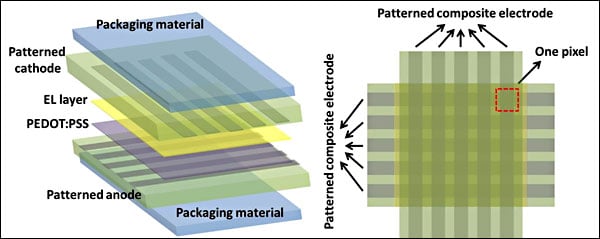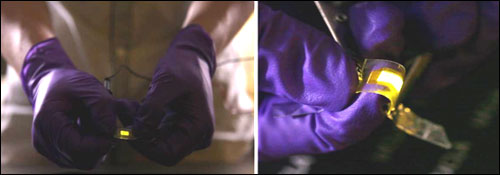
Transparent OLED Display Folds, Stretches
LOS ANGELES, Sept. 24, 2013 — A transparent OLED can be repeatedly stretched, folded and twisted at room temperature while remaining lit and retaining its original shape.
The ultrastretchable display, created at UCLA’s Henry Samueli School of Engineering and Applied Science, could lead to foldable and expandable screens for new classes of smartphones and other personal electronic devices, as well as electronics-integrated clothing, wallpaper-like lighting and minimally invasive medical tools, among other applications.

Schematic (above, left) and top-view (above, right) illustrations of an encapsulated, fully stretchable OLED display comprising 5 × 5 pixels. Images Courtesy of UCLA.
“Our new material is the building block for fully stretchable electronics for consumer devices,” said principal investigator Qibing Pei, a UCLA professor of materials science and engineering. “Along with the development of stretchable thin-film transistors, we believe that fully stretchable interactive OLED displays that are as thin as wallpaper will be achieved in the near future. And this will give creative electronics designers new dimensions to exploit.”

Photographs of a stretchable OLED (original emission area: 5.0 × 4.5 mm) at specified strains (up to 120%).
The team stretched and restretched the OLED a thousand times, extending it 30 percent beyond its original shape and size, and it still continued to work at a high efficiency. In another test to determine the material’s maximum stretch, they found it could be stretched to more than twice its original size while still functioning. In addition, it can be folded 180 degrees and can be twisted in multiple directions.
The material has a single layer of an electro-luminescent polymer blend sandwiched between a pair of new transparent elastic composite electrodes. These electrodes are made of a network of silver nanowires inlaid into a rubbery polymer, which allows the device to be used at room temperature. All of these layers are fully stretchable, foldable and twistable. The new material can also be fabricated in a relatively simple all-solution-based process, they said.

Images of an encapsulated OLED stretched, bent and wrapped around a finger.
“The lack of suitable elastic transparent electrodes is one of the major obstacles to the fabrication of [a] stretchable display,” said lead author Jiajie Liang, a postdoc in Pei’s Soft Materials Research Laboratory at UCLA. “Our new transparent, elastic composite electrode has high visual transparency, good surface electrical conductivity, high stretchability and high surface smoothness — all features essential to the fabrication of the stretchable OLED.”
The team also demonstrated that their ultraflexible OLED could contain multiple pixels, rather than just a solid block of light. This was accomplished by assembling the silver nanowire-based electrodes into a cross-hatched pattern, with one layer of columns and one layer of rows.
“While we perceive a bright future where information and lighting are provided in various thin, stretchable or conformable form factors, or are invisible when not needed, there are still major technical challenges,” Pei said. “This includes how to seal these materials that are otherwise sensitive to air. Researchers around the world are racing the clock tackling the obstacles. We are confident that we will get there and introduce a number of cool products along the way.”
The work, which was funded by the National Science Foundation and the Air Force Office of Scientific Research, was published online in Nature Photonics Sept. 22 (doi:10.1038/nphoton.2013.242).
For more information, visit: www.ucla.edu
Published: September 2013